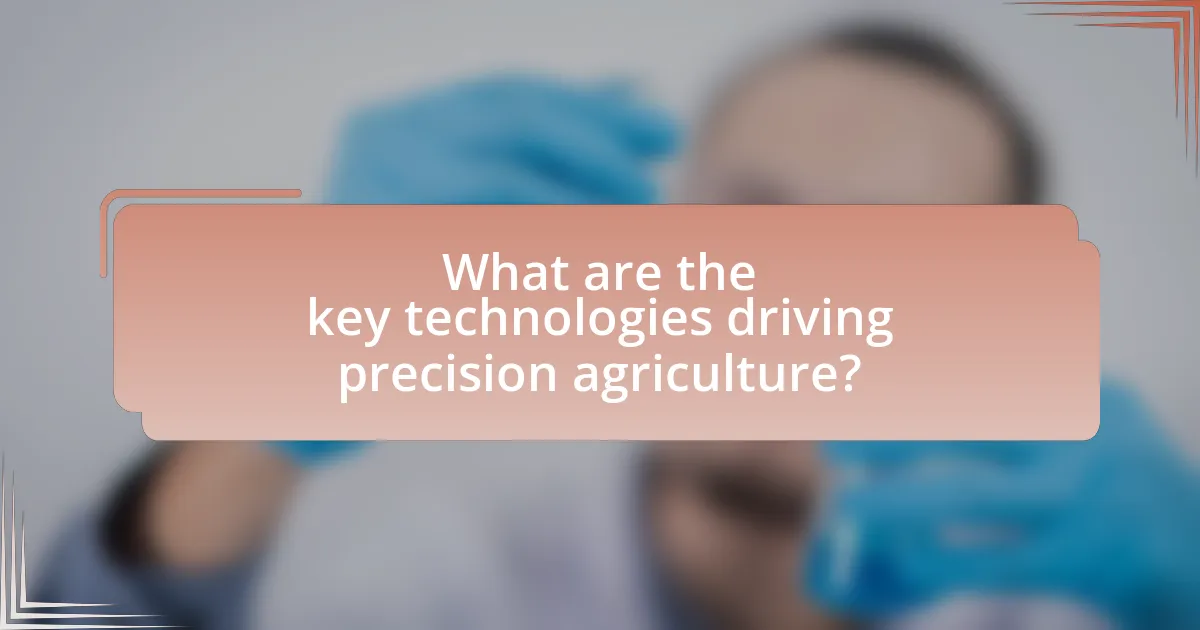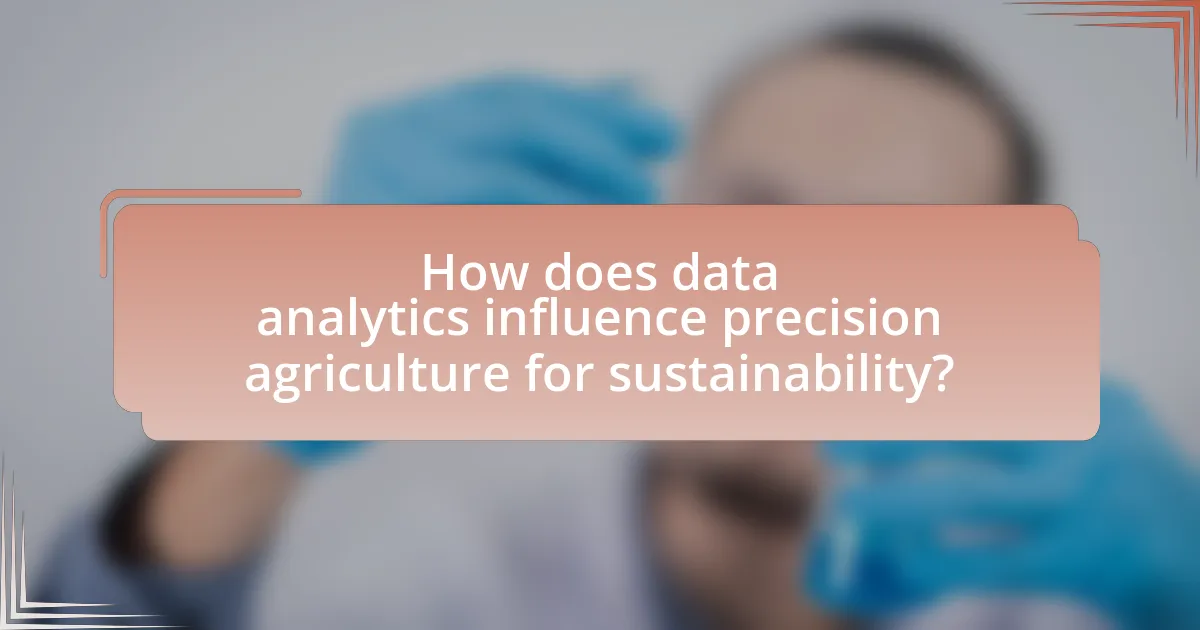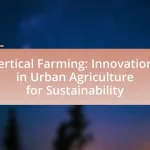The article focuses on the role of technology in precision agriculture and its impact on environmental sustainability. It highlights how technologies such as GPS, remote sensing, IoT devices, and data analytics enhance farming practices by optimizing resource use, reducing waste, and improving crop yields. Key findings indicate that precision agriculture can significantly decrease water and fertilizer usage while minimizing environmental impacts, such as nutrient runoff and greenhouse gas emissions. The article also discusses specific technologies utilized in precision agriculture, the environmental challenges they address, and future trends that may further enhance sustainability in farming practices.

What is the Role of Technology in Precision Agriculture for Environmental Sustainability?
Technology plays a crucial role in precision agriculture by enhancing environmental sustainability through data-driven decision-making and resource optimization. Precision agriculture utilizes technologies such as GPS, remote sensing, and IoT devices to monitor crop health, soil conditions, and weather patterns, allowing farmers to apply inputs like water, fertilizers, and pesticides more efficiently. For instance, a study published in the journal “Agricultural Systems” found that precision agriculture practices can reduce fertilizer use by up to 30%, significantly decreasing nutrient runoff into waterways and minimizing environmental impact. Additionally, the use of drones and satellite imagery enables farmers to identify areas needing attention, leading to targeted interventions that conserve resources and promote biodiversity. Thus, technology in precision agriculture not only boosts productivity but also fosters sustainable farming practices that protect ecosystems.
How does technology enhance precision agriculture practices?
Technology enhances precision agriculture practices by enabling data-driven decision-making and optimizing resource use. Advanced tools such as GPS, remote sensing, and IoT devices allow farmers to monitor crop health, soil conditions, and weather patterns in real-time. For instance, GPS-guided tractors can apply fertilizers and pesticides with high accuracy, reducing waste and minimizing environmental impact. According to a study published in the journal “Precision Agriculture,” the use of precision technologies can increase crop yields by up to 20% while decreasing input costs by 10-15%. This demonstrates that technology not only improves efficiency but also contributes to sustainable agricultural practices.
What specific technologies are utilized in precision agriculture?
Precision agriculture utilizes technologies such as GPS, remote sensing, drones, soil sensors, and data analytics. GPS technology enables precise field mapping and navigation, allowing farmers to optimize planting and harvesting. Remote sensing involves satellite or aerial imagery to monitor crop health and soil conditions, facilitating timely interventions. Drones provide real-time aerial data collection, enhancing field surveillance and crop assessment. Soil sensors measure moisture levels and nutrient content, enabling targeted irrigation and fertilization. Data analytics processes the collected information to inform decision-making, improving yield and resource efficiency. These technologies collectively enhance agricultural productivity while promoting environmental sustainability.
How do these technologies contribute to environmental sustainability?
Technologies in precision agriculture contribute to environmental sustainability by optimizing resource use and minimizing waste. For instance, precision irrigation systems reduce water consumption by delivering the exact amount of water needed to crops, which can decrease water usage by up to 50% compared to traditional methods. Additionally, the use of data analytics and sensors allows farmers to apply fertilizers and pesticides more accurately, reducing chemical runoff into waterways and lowering the overall environmental impact. Studies have shown that these technologies can lead to a significant reduction in greenhouse gas emissions, with some reports indicating a decrease of up to 20% in emissions from agricultural practices when precision methods are employed.
Why is precision agriculture important for environmental sustainability?
Precision agriculture is important for environmental sustainability because it optimizes resource use, reduces waste, and minimizes environmental impact. By utilizing technologies such as GPS, sensors, and data analytics, farmers can apply water, fertilizers, and pesticides more efficiently, leading to lower chemical runoff and reduced soil degradation. For instance, a study published in the journal “Agricultural Systems” found that precision agriculture practices can reduce nitrogen fertilizer use by up to 30%, significantly decreasing the risk of water pollution. This targeted approach not only enhances crop yields but also promotes biodiversity and conserves natural resources, making it a crucial strategy for sustainable farming practices.
What are the environmental challenges that precision agriculture addresses?
Precision agriculture addresses several environmental challenges, including soil degradation, water scarcity, and pesticide overuse. By utilizing technology such as GPS, sensors, and data analytics, precision agriculture optimizes resource use, thereby reducing the negative impacts on the environment. For instance, it enables farmers to apply fertilizers and pesticides more accurately, which minimizes runoff and pollution of water bodies. Additionally, precision irrigation techniques help conserve water by delivering it directly to the plant roots, addressing the challenge of water scarcity in agriculture. Studies have shown that these practices can lead to a significant reduction in chemical inputs and water usage, promoting sustainable farming practices that protect ecosystems.
How does precision agriculture improve resource efficiency?
Precision agriculture improves resource efficiency by utilizing technology to optimize inputs such as water, fertilizers, and pesticides. This approach enables farmers to apply resources more accurately based on real-time data, which reduces waste and enhances crop yields. For instance, studies have shown that precision irrigation can decrease water usage by up to 30% while maintaining or increasing crop productivity. Additionally, precision application of fertilizers can lead to a reduction in chemical runoff, promoting environmental sustainability. These practices not only conserve resources but also contribute to higher economic returns for farmers.

What are the key technologies driving precision agriculture?
Key technologies driving precision agriculture include GPS technology, remote sensing, IoT devices, and data analytics. GPS technology enables farmers to accurately map and manage their fields, enhancing planting and harvesting efficiency. Remote sensing utilizes satellite imagery and drones to monitor crop health and soil conditions, allowing for timely interventions. IoT devices collect real-time data on environmental factors such as moisture and temperature, facilitating informed decision-making. Data analytics processes the vast amounts of data generated, providing insights that optimize resource use and improve yields. These technologies collectively contribute to more sustainable agricultural practices by minimizing waste and maximizing productivity.
How do GPS and GIS technologies impact precision agriculture?
GPS and GIS technologies significantly enhance precision agriculture by enabling farmers to collect and analyze spatial data for improved decision-making. These technologies allow for precise mapping of fields, monitoring of crop health, and efficient resource management, which leads to optimized input usage and increased yields. For instance, a study by the USDA found that the use of GPS-guided equipment can reduce input costs by up to 15% while increasing crop productivity by 10-20%. This data-driven approach not only maximizes agricultural efficiency but also promotes environmental sustainability by minimizing waste and reducing the ecological footprint of farming practices.
What are the benefits of using GPS in farming?
The benefits of using GPS in farming include enhanced accuracy in field mapping, improved efficiency in resource management, and increased crop yields. GPS technology allows farmers to create precise maps of their fields, enabling them to apply inputs like fertilizers and pesticides more accurately, which reduces waste and environmental impact. Studies have shown that GPS-guided equipment can increase productivity by up to 20% by optimizing planting and harvesting processes. Additionally, GPS data helps in monitoring crop health and soil conditions, leading to better decision-making and sustainable farming practices.
How does GIS facilitate better decision-making in agriculture?
GIS facilitates better decision-making in agriculture by providing spatial analysis and data visualization tools that enhance the understanding of land use, crop health, and resource management. By integrating various data sources, such as soil types, weather patterns, and crop yields, GIS enables farmers to make informed decisions regarding planting schedules, irrigation practices, and pest management. For instance, a study by the University of California found that farmers using GIS technology improved their crop yields by up to 20% through optimized resource allocation and targeted interventions. This data-driven approach not only increases productivity but also promotes sustainable agricultural practices by minimizing waste and environmental impact.
What role do sensors and IoT play in precision agriculture?
Sensors and IoT play a critical role in precision agriculture by enabling real-time data collection and analysis, which enhances decision-making for farmers. These technologies facilitate monitoring of soil moisture, temperature, and crop health, allowing for precise irrigation and fertilization. For instance, a study by the University of California found that using soil moisture sensors can reduce water usage by up to 30% while maintaining crop yield. Additionally, IoT devices can connect various agricultural equipment, streamlining operations and improving efficiency. This integration of sensors and IoT not only optimizes resource use but also contributes to sustainable farming practices by minimizing waste and environmental impact.
How do soil and crop sensors improve agricultural practices?
Soil and crop sensors enhance agricultural practices by providing real-time data on soil conditions and crop health. These sensors measure parameters such as moisture levels, nutrient content, and temperature, enabling farmers to make informed decisions about irrigation, fertilization, and pest management. For instance, a study published in the journal “Precision Agriculture” found that the use of soil moisture sensors can reduce water usage by up to 30% while maintaining crop yields. This data-driven approach not only optimizes resource use but also promotes environmental sustainability by minimizing waste and reducing the ecological footprint of farming activities.
What is the significance of IoT in monitoring agricultural conditions?
The significance of IoT in monitoring agricultural conditions lies in its ability to provide real-time data on soil moisture, temperature, and crop health, which enhances decision-making for farmers. By utilizing sensors and connected devices, IoT enables precise monitoring that leads to optimized resource use, increased crop yields, and reduced environmental impact. For instance, a study by the Food and Agriculture Organization (FAO) highlights that IoT applications can improve water management by up to 30%, demonstrating the technology’s effectiveness in promoting sustainable agricultural practices.

How does data analytics influence precision agriculture for sustainability?
Data analytics significantly enhances precision agriculture by optimizing resource use and minimizing environmental impact, thereby promoting sustainability. Through the analysis of large datasets from various sources such as satellite imagery, soil sensors, and weather forecasts, farmers can make informed decisions regarding planting, irrigation, and fertilization. For instance, a study published in the journal “Agricultural Systems” found that data-driven approaches can reduce water usage by up to 30% while maintaining crop yields. This efficiency not only conserves water but also reduces runoff and nutrient leaching, which are critical for protecting local ecosystems. Additionally, data analytics enables real-time monitoring of crop health, allowing for timely interventions that further enhance sustainability efforts.
What types of data are collected in precision agriculture?
Precision agriculture collects various types of data, including soil data, weather data, crop health data, and yield data. Soil data encompasses information on nutrient levels, moisture content, and pH, which helps in understanding soil conditions for optimal crop growth. Weather data includes temperature, rainfall, and humidity, allowing farmers to make informed decisions based on climatic conditions. Crop health data is gathered through remote sensing technologies, such as drones and satellites, which monitor plant health and detect diseases or pests. Yield data is collected during harvest to analyze the productivity of different areas within a field, enabling better planning for future planting seasons. These data types are essential for enhancing agricultural efficiency and sustainability.
How is data analyzed to optimize farming practices?
Data is analyzed to optimize farming practices through techniques such as data collection, statistical analysis, and predictive modeling. Farmers utilize sensors, satellite imagery, and IoT devices to gather real-time data on soil conditions, crop health, and weather patterns. This data is then processed using statistical methods to identify trends and correlations, enabling farmers to make informed decisions regarding irrigation, fertilization, and pest management. For instance, a study published in the journal “Precision Agriculture” found that data-driven decision-making can increase crop yields by up to 20% while reducing resource use by 30%. This demonstrates the effectiveness of data analysis in enhancing agricultural efficiency and sustainability.
What insights can farmers gain from data analytics?
Farmers can gain insights from data analytics that enhance decision-making, optimize resource use, and improve crop yields. By analyzing data from various sources such as soil sensors, weather forecasts, and satellite imagery, farmers can identify patterns and trends that inform planting schedules, irrigation needs, and pest management strategies. For instance, a study by the International Food Policy Research Institute found that data-driven practices can increase crop yields by up to 30% while reducing water usage by 20%. This demonstrates the effectiveness of data analytics in promoting sustainable agricultural practices.
How can farmers implement technology for sustainable practices?
Farmers can implement technology for sustainable practices by utilizing precision agriculture tools such as GPS-guided equipment, soil sensors, and data analytics platforms. These technologies enable farmers to optimize resource use, reduce waste, and enhance crop yields while minimizing environmental impact. For instance, GPS-guided tractors can apply fertilizers and pesticides more accurately, reducing chemical runoff and improving soil health. Additionally, soil sensors provide real-time data on moisture levels, allowing farmers to irrigate more efficiently, which conserves water resources. Research indicates that precision agriculture can lead to a 10-20% increase in crop productivity while decreasing input costs and environmental degradation, demonstrating its effectiveness in promoting sustainable farming practices.
What are the best practices for integrating technology in farming?
The best practices for integrating technology in farming include adopting precision agriculture techniques, utilizing data analytics, implementing automated systems, and employing sustainable practices. Precision agriculture techniques, such as GPS-guided equipment and soil sensors, enable farmers to optimize resource use and increase crop yields while minimizing environmental impact. Data analytics allows for informed decision-making by analyzing weather patterns, soil health, and crop performance, leading to more efficient farming practices. Automated systems, including drones and robotic machinery, enhance operational efficiency and reduce labor costs. Sustainable practices, such as integrated pest management and crop rotation, further support environmental sustainability by promoting biodiversity and reducing chemical usage. These practices collectively contribute to a more efficient, productive, and environmentally friendly agricultural sector.
What challenges might farmers face when adopting new technologies?
Farmers may face several challenges when adopting new technologies, including high initial costs, lack of technical knowledge, and resistance to change. High initial costs can deter farmers from investing in advanced equipment or software, as many technologies require significant upfront capital. Additionally, a lack of technical knowledge can hinder effective implementation and utilization of these technologies, as farmers may not be familiar with operating new systems or interpreting data. Resistance to change often stems from traditional farming practices and skepticism about the benefits of new technologies, which can slow down the adoption process. According to a study published in the journal “Agricultural Systems,” these barriers significantly impact the rate of technology adoption in agriculture, highlighting the need for targeted support and training programs to facilitate smoother transitions.
What are the future trends in technology for precision agriculture?
Future trends in technology for precision agriculture include the increased use of artificial intelligence (AI), machine learning, and advanced data analytics. These technologies enable farmers to analyze vast amounts of data from various sources, such as satellite imagery and sensor networks, to optimize crop management and resource allocation. For instance, AI-driven algorithms can predict crop yields and identify pest infestations early, allowing for timely interventions. Additionally, the integration of Internet of Things (IoT) devices will facilitate real-time monitoring of soil conditions and weather patterns, enhancing decision-making processes. According to a report by MarketsandMarkets, the precision agriculture market is projected to grow from $7 billion in 2020 to $12 billion by 2025, highlighting the increasing adoption of these technologies in the agricultural sector.
How might advancements in technology further enhance sustainability?
Advancements in technology can enhance sustainability by optimizing resource use and minimizing waste in agriculture. For instance, precision agriculture technologies, such as GPS-guided equipment and soil sensors, enable farmers to apply water, fertilizers, and pesticides more efficiently, reducing overuse and runoff. Research from the University of California found that precision agriculture can decrease water usage by up to 30% while maintaining crop yields. Additionally, data analytics and machine learning can predict crop health and yield, allowing for timely interventions that further reduce environmental impact. These technological innovations not only improve productivity but also contribute to long-term ecological balance.
What role will artificial intelligence play in the future of precision agriculture?
Artificial intelligence will play a crucial role in the future of precision agriculture by enhancing decision-making processes and optimizing resource management. AI technologies, such as machine learning and data analytics, will enable farmers to analyze vast amounts of data from various sources, including soil sensors, weather forecasts, and satellite imagery. This analysis will lead to more accurate predictions regarding crop yields, pest infestations, and irrigation needs. For instance, a study by the International Society of Precision Agriculture found that AI-driven tools can increase crop productivity by up to 20% while reducing water usage by 30%. Such advancements will not only improve agricultural efficiency but also contribute to environmental sustainability by minimizing waste and conserving resources.
What practical tips can farmers follow to leverage technology for sustainability?
Farmers can leverage technology for sustainability by adopting precision agriculture tools such as GPS-guided equipment, soil sensors, and data analytics platforms. These technologies enable farmers to optimize resource use, reduce waste, and enhance crop yields. For instance, GPS-guided tractors can minimize overlap during planting and fertilization, leading to lower input costs and reduced environmental impact. Soil sensors provide real-time data on moisture levels, allowing for targeted irrigation that conserves water. Additionally, data analytics can help farmers make informed decisions based on historical trends and predictive models, ultimately promoting sustainable farming practices.


